Health and Disease
Plague
Plague is a disease is caused by a bacterium usually found in small animals and their fleas. Untreated, 30%-60% of people who become infected die; it has been responsible for several pandemics throughout history, of which the Black Death in the 14th century was one. Bubonic plague, where the lymph nodes become swollen (forming 'buboes') is the most common form.
http://www.who.int/mediacentre/factsheets/fs267/en/ - Accessed 16-05-2016
The Black Death spread throughout Europe between circa 1346-53.
The average number of vicars 'instituted' in the Exeter diocese because of death or resignation was usually 36 a year - in April 1349 alone there were 53.
John de Undele had been vicar of Ashburton since 1335, but he was succeeded in 1348 by David Penylis, who died just before Christmas. Richard Yurl was instituted on January 1st, but Thomas de Botercombe was instituted only ten days later.
Preface to The Register of John de Grandisson, Bishop of Exeter, the Rev F C Hingeston-Randolph, London 1899, p lxxxvii
http://www.historytoday.com/ole-j-benedictow/black-death-greatest-catastrophe-ever - Accessed 06-10-2016
'The lands with which this chapel [St Lawrence] were endowed were valued in the reign of Edward VI at 10l 15s 8d per annum. The overplus was appropriated to the maintenance and reparation of leaden pipes "for the conduction of holsome water for the relief of the infected when the plague should be at Ashburton, that they might not infect others."
'Chantry Roll in the Augmentation Office, quoted by Daniel and Samuel Lysons in Magna Britannia, London 1822, p13
In 1625* Ashburton was visited with an outbreak of plague, and the registers record the deaths of no less than seven members of this family in four months.
February 16th A servant of John Fabyan
March 14th The Master John Fabyan
April 9th Samuel son of Nicholas Fabyan
April 13th Margaret Fabyan
April 16th Mary Fabyan
April 21st Grace Fabyan
May 5th Philip Fabyan.'
Edward Windeatt, Early Nonconformity in Ashburton, Transactions of the Devonshire Association vol. 28,1896, p234ff
*Old calendar - we would say 1626. In the parish registers John appears as Johes, Margaret as Margaretta, Mary as Maria and Grace as Gracia. The surname appears as Fabia/Fabian
Parish registers
July 29th 1626 'Plymouth, Ashburton and Okehampton very much infected with the plague. Exeter is reasonably clear.'
Calendar of State Papers Domestic, Charles I, 1625-1626, ed John Bruce, vol 32, London 1858, pp 380-392During
Charles I's reign (1625 -1649) 'the plague appears to have pressed very
heavily upon the county at frequent intervals.........The regular
course seems to have been to shut up in their own houses persons who
were either infected, or had been in the company of infected people, and
thus to try and isolate the disease. As such persons could not follow
their usual avocations, some small weekly pittance was allowed for their
support, and a rate for this purpose was levied upon the adjoining
hundred.........Totnes, Ashburton, Buckland and North Bovey had £150
between them'.
Quarter Sessions from Queen Elizabeth to Queen Anne, A H A Hamilton,1878, pp105,106
Paul Slack has calculated that between August 1625 and
July 1626 there were 388 burials in Ashburton - against an average of
47 at the time*.
The impact of plague in Tudor and Stuart England, Paul Slack, publ Routledge & Kegan Paul, 1985, p90
*Other figures are given elsewhere, possibly because of the dates chosen for the calculation
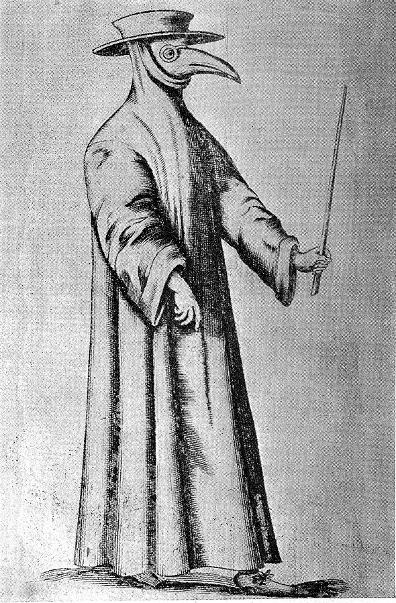
Image no L0025221 from the Wellcome Library, London. Many thanks to the Wellcome Library, London, which kindly allows images from its Digital Gallery to be used under this Creative Commons License for educational and non-commercial purposes.
Parish records.
*******
http://bcw-project.org/military/english-civil-war/west-country/
Cholera
'Cholera - A very fatal epidemic disease, characterised by excessive vomiting and purging, with cramps and great prostration. '
From: Hadden's pocket vocabulary of medical terms, for the use of Registrars, Poor Law officials, etc
Henry Payne M.D., Hadden, Best and Co., London 2nd edition 1892
Cholera, a water-borne disease, did not appear in England until 1831, but worldwide there were 8 pandemics between 1817 and 1902.
John Snow, a major force in identifying the cause and spread of the disease, reported on 'the mixture of cholera evacuations with the water used for drinking and culinary purposes, either by permeating the ground and getting into wells,or by running along channels and sewers into the rivers from which entire towns are sometimes supplied with water'.
Disease and history, Frederick F Cartwright and Michael D Biddiss, Dorset Press, New York, 1972 pp 158,160
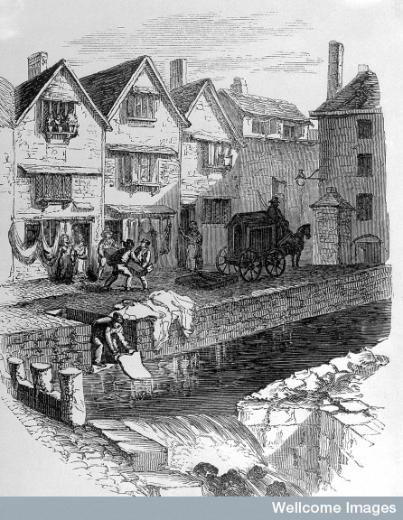
Left: Washing cholera clothes in Exeter
Credit: Wellcome Library, London. Many thanks to the Wellcome Library, London, which kindly allows images from its Digital Gallery to be used under this Creative Commons License for educational and non-commercial purposes.
From: The history of cholera in Exeter in 1832, Thomas Shapter, publ J Churchill, London, 1849
Ashburton, September 1st 1832 John Elliott, a baker aged 67, died of cholera.
In 1832 46 persons were 'taken off' in the space of a month: this was followed by Board of Health regulations, apparently effectively enforced.
In October of that year the Cheltenham Gazette reported that the progress of the disease had been virtually stopped in Ashburton by scattering lime in the streets and burning tar barrels
North Devon Journal 13 Sept 1832 p3 col3
Cheltenham Gazette 18 Sept 1832, quoted in
Exeter and Plymouth Gazette, 6 October 1832 p4 col3
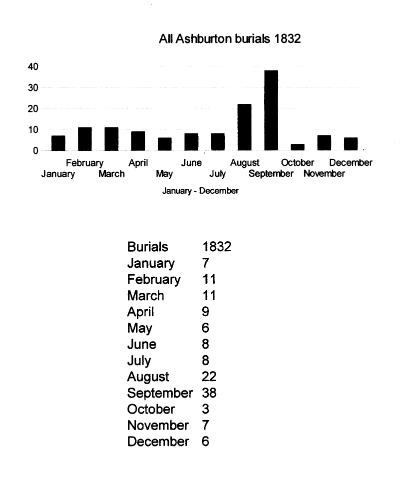
At a public meeting in Exeter in 1846, the subject of water and sewerage was on the agenda. The question of what to do with sewerage after it had passed through any pipes seemed to have been solved by places as diverse as Edinburgh, Crediton and Ashburton, where waste was distributed over a large section of land, and made valuable manure.
Western Times 5 December 1846 p6 col1
Exeter and Plymouth Gazette, 6 October 1849 p5 col5
Western Times10 November 1849 p7 col6
Western Times 24 September 1853 p7 col4
However in 1854 Mr. Hele, the medical officer,
reported to the Board of Guardians that many people in Ashburton had
diarrhoea. As there was cholera in London he suggested that the Board
looked at the cleanliness in tenements and back premises, where there
was poor drainage and little water.
Western Times 19 August 1854 p6 col2
A month later a correspondent to the same newspaper claimed that it was a 'monstrous absurdity' that sewers were being cut in the town, without sufficient water to flush them through, especially as cholera was advancing through the country.
Western Times 2 September 1854 p7 col6
A new sewer was being installed in East Street in 1856. An old street and pavement were found about a foot and a half below the current surface, and the Western Times commented that a large open gutter used to run in the centre of the street, down to the river at the Bullring.
Western Times 2 August 1856, p7 col3
In 1866 a travelling woman attending Ashburton fair was diagnosed with cholera by Dr MacGill.
Western Times 17 August 1866 p8 col1
*******
Smallpox
December 1867 The Exeter and Plymouth Gazette reported that smallpox was still active in Ashburton, but patients were recovering.
Exeter and Plymouth Gazette 27 December 1867 p7 col2
*******
In 1843 a Mr Coles, 'Surgeon-dentist' based at Plymouth, could be consulted at Ashburton on the first Tuesday of every month from 11 until 4.
By 1870 Mr D M Ching, also a surgeon dentist, was offering a similar service. Also based at Plymouth, he could be consulted on the third Saturday in each month, at Mr Giles, East Street. Artificial teeth cost from 5s each - a complete set was £3 3s.
Exeter and Plymouth Gazette 3 June 1843 p2 col6
Totnes Weekly Times, 30 July 1870, p1col1
*******
Exeter Flying Post 12 August 1863, p7 col6
The 1861 census shows George, aged 5, living in North St with his father, chemist and druggist George Wills Yolland
https://www.freecen.org.uk
*******
East and South Devon Advertiser, 30 October 1875, p5 col5
*******
Western Morning News 14 September 1877 p3 col2
*******
Western Times 5 August 1903, p1 col1
A Cure for Everything
In the early 1800s a James Morison, 'Hygiest', created a vegetable universal pill to cure all ills: consumption, nervous complaints, ossification of the heart, hooping cough, vomiting etc. etc. The 'British College of Health' which features in the title of his book was Morison's own creation: 'One of the cleverest things he ever did' according to John Malcolm Bulloch.
Mr John Lopus was the Ashburton agent.
Morisoniana, or Family Advisor for the British College of Health, London 1831, p589
John Malcolm Bulloch, the Centenary of James Morison the 'Hygiest', 1925, quoted in http://www.ucl.ac.uk/bloomsbury-project/institutions/british_college_of_health.htm - Accessed 8-05-2016
*******
Ashburton and Buckfastleigh Cottage Hospital
In Victorian times if you were ill and wealthy you paid
for a doctor to see you in your own home. If you were ill and poor you
treated yourself - or attended a charitable hospital or a workhouse
infirmary if you were seriously ill.
Below and below right: doctors' invoices for 'attendance and medicine' for Mr George Yolland and Mrs Yolland.
In 1872 the doctor is W S Gervis; in 1881 the doctors are Gervis and Fraser.
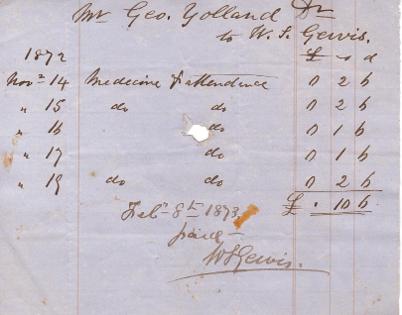
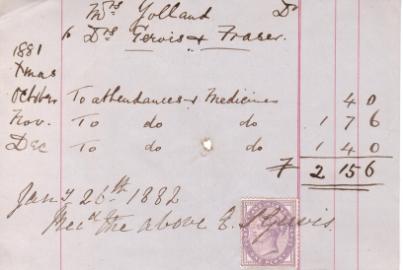
In August 1875 a meeting in the Town Hall recognized that the better off in the community 'were all bound to do what good they could to their poorer neighbours', and resolved to build a Cottage Hospital in the town.
Western Times 31 August 1875 p8 col6
At the initial meeting were, amongst others:
B J P Bastard
D R Scratton
T H Firth
Rev J Gill (Holne)
Rev P Jackson (Leusdon)
Rev J W Lay
Dr Adams
Dr Johnson
Sir R Torrens
Major Tucker
Capt Lloyd
Capt Brooman
Capt. Stone
P F S Amery
P S Amery
Western Times 31 August 1875 p8 col6
My own photograph 2013
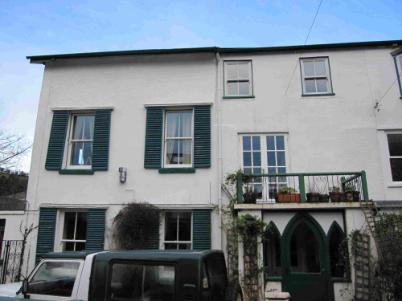
Rural Sanitary Authority 1877
'Ashburton exhibits the remarkably low mortality of less than 8 per 1000.....'
Western Times 24 April 1877 p7 col1
The medical officers were:
Mr Ubsdell
The 1881 census shows Henry Ubsdell, a 42 year old General Practitioner, living in Market Street, Buckfastleigh. Unmarried, he was born in Middlesex.
1881 census RG11, Piece 2177, Folio 62, p21
Dr Johnson
Dr Adams
Probably the James Adams of the 1881 census, 31 at that time and living in East Street
1881 census RG11 Piece 2161, Folio 23, p2
As to the nurses required, several local advertisements at this time seek 'a middle aged woman' for the post.
Exeter & Plymouth Gazette 17 February 1876 p 4 col1
and Exeter & Plymouth Gazette 20 May 1876 p 2 col1
Thanks to Hazel Bray for information on the name of the hospital
1878 Mrs Christiana Daw is matron of the Ashburton and Buckfastleigh Cottage Hospital, Church Lane
(Mrs Christian Daw in another entry on the same page).
White's History, Gazetteer and Directory of Devon, 1878-79, p108
In 1880 a new entrance to the hospital from the Station was made, giving patients a better view, and also allowing passengers on the train to see the hospital - presumably beneficial for fund-raising. It also allowed vehicles to stop near the door.
Western Times 1 June 1880 p5 col5
The 1881 census shows Clara Walters as the hospital nurse and matron at the Church Lane premises (https://familysearch.org/), assisted by a servant, Mary Bickford.
There are 4 patients:
Edward Willis
James Townsend
John Halse
Eliza Coutier
Some patients at the Cottage Hospital
Thomas Smerdon, an 'elderly labourer', employed at Horsehill Farm.
One rib and shoulder bone broken, plus a scalp wound, after being dragged by a horse.
Western Times 16 June1884 p2 col1
John Michelmore of Brixham, employed at the paint works near Gulwell Bridge.
Right leg amputated after he became entangled in machinery
Western Times 8 September 1885 p3 col5
The son of Mr G Pitts (butcher) broke both bones in his right leg whilst playing football, and was taken to the Hospital
Western Times 28 March 1894 p4 col3
In 1901 two sons of R B Joint, mason, died in the Cottage Hospital. They had contracted scarlet fever 5 weeks earlier, but had appeared to recover. Dr Rawson attended them both when they became ill again, and had them moved to the hospital, where they died the same day. They were aged 8 and 9.
Western Morning News 9 October 1901, p6 col5
A son of Mr W. Yeo of the Engineer Arms Inn.
Following boys on the Terrace Walk, hit in the back with a large stone which rendered him senseless.
Attended to at the hospital by Dr Fitzpatrick.
Western Times 14 April 1906 p3 col7
William Furze, employed by Mr J Smerdon at Gaye's Farm.
Severely cut his arm whilst pruning a hedge.
Western Times 25 May 1906 p3 col7
Henry F Prout, employed by Mr G Allen of Wickeridge House, Woodland.
Seriously injured his back when a barrel of oil fell on him at the goods shed of the Railway Station.
Exeter & Plymouth Gazette14 August 1908 p3 col6
Peter Foot of Widecombe in the Moor.
Thrown from a horse at Great Bridge. In a critical condition at the time of the newspaper report.
Exeter & Plymouth Gazette1 June 1912 p3 col4
Sadly the hospital could not help everyone:
George Henry Hamlyn, son of William Henry Hamlyn, of Hannaford's Court, Ashburton.
Hit by a motor car and taken to the Cottage Hospital, but he was dead on arrival.
Western Times 31 March 1923 p3 col5
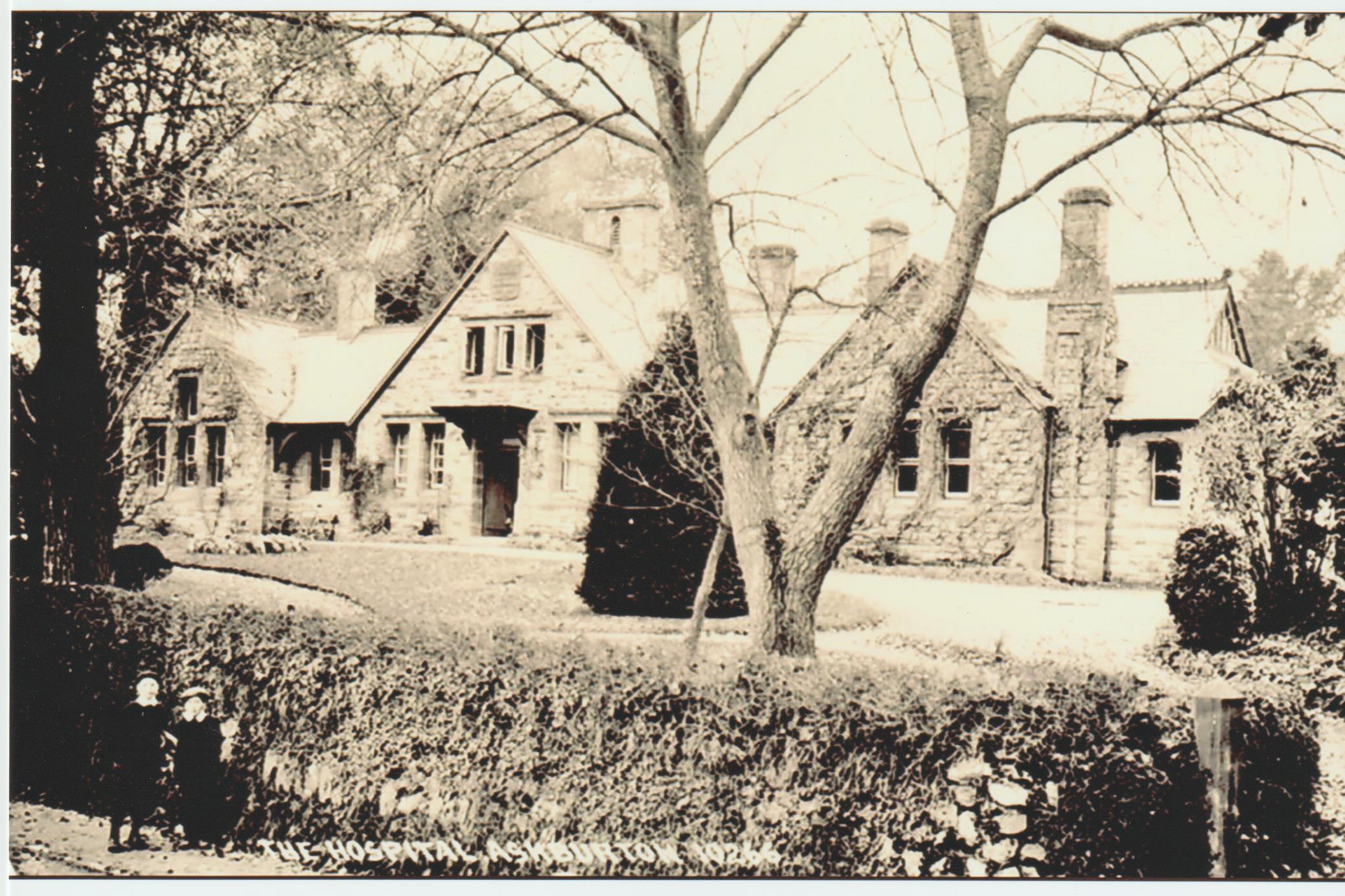
In 1891 Margaret Mary Ayres is the 'Matron nurse' of the new premises.(http://www.freecen.org.uk/cgi/search.pl)
The servant is Sarah Ann Petherbridge, and there are 6 patients:
Samuel Lear
Samuel Waldron
Walter Alma Butland
Ernest Furse
Elizabeth Jane White
Fanny Henrietta Hannaford
The 10 bed hospital was described by Kelly's Directory as 'Well supplied by subscriptions'. It was also endowed by bequests from Mrs Larpent and Miss Michelmore
Kelly's Directory of Devonshire 1902, p30
Medical Offiers at the Hospital in 1902, from Kelly's Directory of Devonshire 1902 p32:
Henry Ubsdell
Wilson Ranson
In 1901 30 year old Wilson Ranson was living in East Street. Born in Norwich(?), Norfolk the entry appears to read 'surgeon'.
1901 census RG13, Piece 2053, Folio 39, p9
John William Wyncoll
In 1901 38 year old John W. Wyncoll was living in Plymouth Road, Buckfastleigh. Born in Halifax, Yorkshire, he was a physician and surgeon.
1901 census RG13, Piece 2074, Folio 46, p4
Ernest Wilcox
In 1901 44 year old Ernest Wilcox was living in West Street, near to Sparnham. Born in St. Neots, Huntingdonshire, he was a surgeon and general practitioner.
1901 census RG13, Piece 2053, Folio 21, p8
Miss M G Somers-James, Matron nurse
In 1901 Mary G. S.James is shown at the Cottage Hospital, a 29 year old matron. She was born in Egg Buckland, Devon.
1901 census RG13, Piece 2053, Folio 45, p21
In 1917 The British Journal of Nursing reported that Miss Amy F M Horne had been appointed as Matron. She had held posts in Kent, but had also been sister at Brixham hospital and matron of Bovey Tracey and District Hospital.
British Journal of Nursing September 15th 1917
In 1919 Miss Jessie M. Taylor was appointed
Matron.
British Journal of Nursing January 11th 1919
Western Times 24 December 1925 p5 col6
Medical Offiers at the Hospital in 1935:
D C Clark
E A Ellis
S R Williams
Miss E O Ironside
Miss B Gower, Matron
Kelly's Directory of Devonshire 1935 p33
In the early 1940s the dustbin lorry doubled as an ambulance - a section could be removed and another section inserted. When Jack Bligh, the manager of the quarry, was hit on the head by a stone, he was transported to the Cottage Hospital in this vehicle.
Remembered by Wendy Major, Jack's daughter.
In 1947 the Secretary's report stated that the trustees had purchased a quarter of an acre of land to the west of the hospital. The plan was to have enough space to build a nurses' home: 'It was felt that if there were not space for a suitable building when the Government took over it might endanger the future of the hospital'.
Western Times 28 February 1947 p8 col5
Right: 1950s. Ellen Bligh (second from right) with, I believe, Sister Elizabeth Matthews, Sylvia Allen and Eva Rowe (extreme right)
From my own collection.
One story that Ellen told was of an elderly male who died. His grieving widow insisted on retrieving his false teeth, explaining 'We share them'.
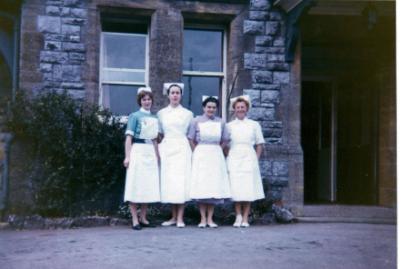
The poet Stevie Smith (Florence Margaret Smith) died of a brain tumour in Ashburton Hospital in March 1971. She had been born in Hull in 1902, later moving to London, but towards the end of her life she spent a lot of time with her sister, who lived in the area. Her best known poem is 'Not Waving but Drowning.'
http://www.strange-attractor.co.uk/stevibio.htm
*******
Visiting the doctor
'(In the 1920s) there were two doctors in the town, one at the top of East Street, and the other better known in West Street, opposite the parish church. Dr Ellis, who was our doctor, was a tall, thin, austere looking man who presided in the surgery in West Street. I learnt from him at a very early age not to judge by appearances. I was taken to visit him one evening by my mother for some minor complaint. We entered by the double doors and walked over the paved courtyard to the entrance. Emerging was a young woman with a baby in a pram and two young children holding her skirts. When we saw the doctor my mother asked him how such an overburdened patient would be able to pay him. "Florence", said Dr. Ellis, "come to my desk". One ledger was open and he showed her a list of names to which he added ours. "You and all the patients here will be receiving a bill from me which you will pay promptly." Bringing over another tome he said, "the patient who has just gone out will find her name here. Those people will not be receiving an account. In the fullness of time, God will repay me." A salutary lesson for a small girl to learn, but one I have never forgotten. After this encounter I watched Dr. Ellis with his elegant wife and young son at church each Sunday and felt that he must have had some special relationship with God. I even wondered if some sign would appear to acknowledge his goodness.
As well as the childhood infections of measles, mumps, whooping cough and scarlet fever, impetigo and scabies was common. Ear infections were often treated at home with old wives' remedies, and warts were charmed away.
In this period, a group of well meaning men, including my father, founded “The Hospital Scheme”. On a Friday night (the men would have been paid that day) they would go out with a notebook and a drawstring bag to collect the dues. One penny per week for a single person, two pence for a married couple and three pence for a family, irrespective of the number of children. When accidents or illness befell and the doctor pronounced “Hospital” the scheme would pay the bill – twenty five shillings a week whether it was the local hospital or the new one at Torquay, so far away. Patients who were unfortunate enough to be suffering from tuberculosis would be sent to Hawkmoor between Bovey Tracy and Morton Hampstead. Patients were conveyed to the local hospital in what I can only describe as an elongated perambulator. It had a brown canvas hood and cover and was pushed by two St John Ambulance men. It can still be seen in the St John Ambulance Hall today.
A relative being sent to Hawkmoor caused great hardship to the family as it was a difficult journey to make to visit the patients. It meant getting a bus to Bovey Tracy and then another bus to take them on the final part of the journey. Fares were not often easy to find and the lonely waits for connections to and from the hospital made a sad journey almost unbearable. Few survived tuberculosis, caused by poor housing and bad nutrition. No doubt the victim, if the breadwinner, would worry about his wife and family and how they would survive without him, but as always neighbours and friends, poor as they were, helped those more unfortunate than themselves. Adults whispered the words “tuberculosis” or” cancer” knowing they meant a death sentence to the patient.
People rallied to help each other when misfortune struck a family. Neighbours supported unfortunates who had fallen on bad times. Straw would be laid in the street outside the sick person’s home to deaden the sound of horses and carts passing up and down. Beef tea was made by those who could afford to spare meat. Shin of beef was cut up, placed in a stone jar and covered with water; the jar had a cloth tied firmly on the top. This was steeped for many hours on the top of a range. After a day and night the concoction was strained and the liquid was ready for the invalid to drink. Sadly, in most cases it proved ineffective.
Many thanks to Hazel Bray for the above item.
Note. The National Health Service was not launched until 5 July 1948. For general archive material on its early years, see http://www.bbc.co.uk/archive/nhs/
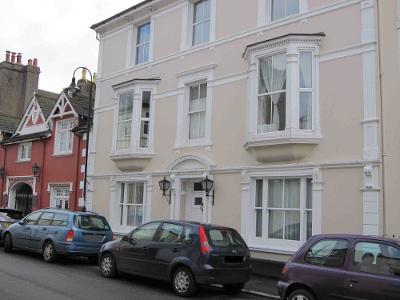
Left: 68 East Street.
My own photograph 2016